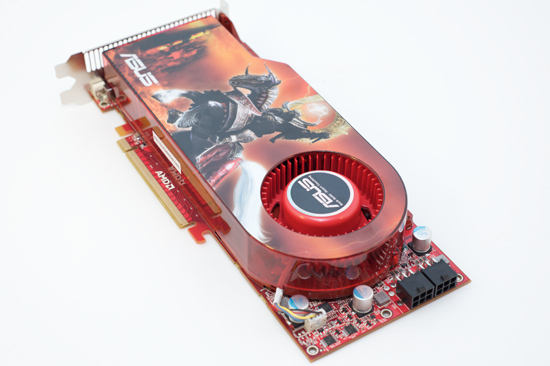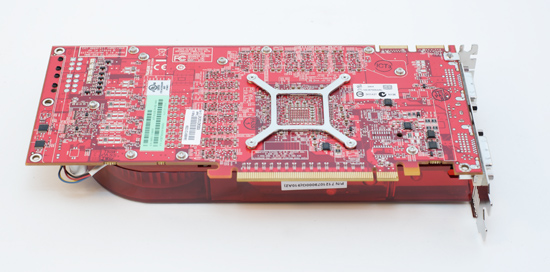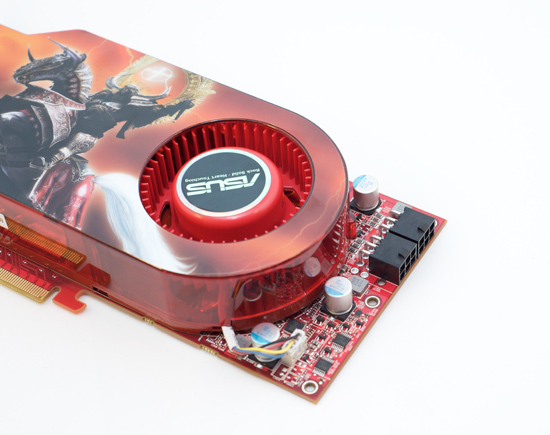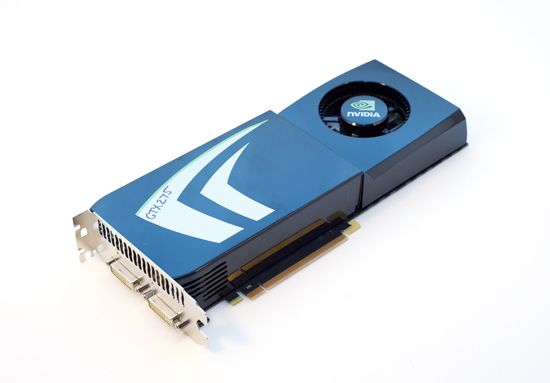ATI Radeon HD 4890 vs. NVIDIA GeForce GTX 275
by Anand Lal Shimpi & Derek Wilson on April 2, 2009 12:00 AM EST- Posted in
- GPUs
The Cards and The Test
In the AMD department, we received two cards. One was an overclocked part from HIS and the other was a stock clocked part from ASUS. Guess which one AMD sent us for the review. No, it's no problem, we're used to it. This is what happens when we get cards from NVIDIA all the time. They argue and argue for the inclusion of overclocked numbers in GPU reviews when it's their GPU we're looking at. Of course when the tables are turned so are the opinions. We sincerely appreciate ASUS sending us this card and we used it for our tests in this article. The original intent of trying to get a hold of two cards was to run CrossFire numbers, but we only have one GTX 275 and we would prefer to wait until we can compare the two to get into that angle.



The ASUS card also includes a utility called Voltage Tweaker that allows gamers to increase some voltages on their hardware to help improve overclocking. We didn't have the chance to play with the feature ourselves, but more control is always a nice feature to have.

For the Radeon HD 4890 our hardware specs are pretty simple. Take a 4870 1GB and overclock it. Crank the core up 100 MHz to 850 MHz and the memory clock up 75 MHz to 975 MHz. That's the Radeon HD 4890 in a nutshell. However, to reach these clock levels, AMD revised the core by adding decoupling capacitors, new timing algorithms, and altered the ASIC power distribution for enhanced operation. These slight changes increased the transistor count from 956M to 959M. Otherwise, the core features/specifications (texture units, ROPs, z/stencil) remain the same as the HD4850/HD4870 series.
Most vendors will also be selling overclocked variants that run the core at 900 MHz. AMD would like to treat these overclocked parts like they are a separate entity altogether. But we will continue to treat these parts as enhancements of the stock version whether they come from NVIDIA or AMD. In our eyes, the difference between, say, an XFX GTX 275 and an XFX GTX 275 XXX is XFX's call; the latter is their part enhancing the stock version. We aren't going to look at the XFX 4890 and the XFX 4890 XXX any differently. In doing reviews of vendor's cards, we'll consider overclocked performance closely, but for a GPU launch, we will be focusing on the baseline version of the card.
On the NVIDIA side, we received a reference version of the GTX 275. It looks similar to the design of the other GT200 based hardware.

Under the hood here is the same setup as half of a GTX 295 but with higher clock speeds. That means that the GTX 275 has the memory amount and bandwidth of the GTX 260 (448-bit wide bus), but the shader count of the GTX 280 (240 SPs). On top of that, the GTX 275 posts clock speeds closer to the GTX 285 than the GTX 280. Core clock is up 31 MHz from a GTX 280 to 633 MHz, shader clock is up 108 MHz to 1404 MHz, and memory clock is also up 108 MHz to 2322. Which means that in shader limited cases we should see performance closer to the GTX 285 and in bandwicth limited cases we'll still be faster than the GTX 216 because of the clock speed boost across the board.
Rather than just an overclock of a pre-existing card, this is a blending of two configurations combined with an overclock from the two configurations from which it was born. And sure, it's also half a GTX 295, and that is convenient for NVIDIA. It's not just that it's different, it's that this setup should have a lot to offer especially in games that aren't bandwidth limited.
That wraps it up for the cards we're focusing on today. Here's our test system, which is the same as for our GTS 250 article except for the addition of a couple drivers.
The Test
| Test Setup | |
| CPU | Intel Core i7-965 3.2GHz |
| Motherboard | ASUS Rampage II Extreme X58 |
| Video Cards | ATI Radeon HD 4890 ATI Radeon HD 4870 1GB ATI Radeon HD 4870 512MB ATI Radeon HD 4850 NVIDIA GeForce GTX 285 NVIDIA GeForce GTX 280 NVIDIA GeForce GTX 275 NVIDIA GeForce GTX 260 core 216 |
| Video Drivers | Catalyst 8.12 hotfix, 9.4 Beta for HD 4890 ForceWare 185.65 |
| Hard Drive | Intel X25-M 80GB SSD |
| RAM | 6 x 1GB DDR3-1066 7-7-7-20 |
| Operating System | Windows Vista Ultimate 64-bit SP1 |
| PSU | PC Power & Cooling Turbo Cool 1200W |










294 Comments
View All Comments
7Enigma - Thursday, April 2, 2009 - link
Deja vu again, and again, and again. I've posted in no less than 3 other articles how bad some of the conclusions have been. There is NO possible way you could conclude the 275 is the better card at anything other than the 30" display resolution. Not only that, but it appears with the latest Nvidia drivers they are making things worse.Honestly, does anyone else see the parallel between the original OCZ SSD firmware and these new Nvidia drivers? Seems like they were willing to sacrifice 99% of their customers for the 1% that have 30" displays (which probably wouldn't even be looking at the $250 price point). Nvidia, take a note from OCZ's situation; lower performance at 30" to give better performance at 22-24" resolutions would do you much better in the $250 price segment. You shot yourselves in the foot on this one...
Gary Key - Thursday, April 2, 2009 - link
The conclusion has been clarified to reflect the resolution results. It falls right into line with your thoughts and others as well as our original thoughts that did not make it through the edits correctly.7Enigma - Thursday, April 2, 2009 - link
Yup, I responded to Anand's post with a thank you. We readers just like to argue, and when something doesn't make sense, we're quick to go on the attack. But also quick to understand and appreciate a correction.duploxxx - Thursday, April 2, 2009 - link
Just some thoughts:There is only 1 single benchmark out of 7 where the 275 has better frame rates for 1680 and 1920 resolution against the 4890 and yet your final words are that you favor the 275???? Only in 2560 the 275 is clearly the better choice. Are you already in the year 2012 where 2560 might be the standard resolution of the sales, it is only very recent that the 1680 became standard and even then this resolution is high for global OEM market sales. Your 2560 is not even few % of the market.
I think you have to clarify your final words a bit more with your choice.... Perhaps if we see power consumption, fan noice etc that would be added value to the choice, but for now, TWIMTBP is really not enough push to prefer the card, I am sure the red team will improve there drivers as usual also.
anything else i missed in your review that could counter my thoughts?
SiliconDoc - Monday, April 6, 2009 - link
Derek has been caught in the 2560 wins it all no matter what with the months on end of ati taking that cake since the 4870 releasse. No lower resolutions mattered for squat since the ati lost there - so you'll have to excuse his months long brainwashing.Thankfully anand checked in and smacked it out of his review just in time for the red fanboy to start enjoying lower resolution wins while nvidia takes the high resolution crown, which is- well.. not a win here anymore.
Congratulations, red roosters.
duploxxx - Thursday, April 2, 2009 - link
just as addon, I also checked some other reviews (yes i always read anandtech first as main source of info) and i saw that it is cooler then a 4870 and actually consumes 10% less then a 4870 so this can't be the reason either while the 275 stays at the same 280 power consumption. Also OC parts are already shown GPU above 1000....cyriene - Thursday, April 2, 2009 - link
I would have liked to see some information on heat output and the temperatures of the cards while gaming.Otherwise, nice article.
7Enigma - Thursday, April 2, 2009 - link
This is an extreme omission. The fact that the 4890 is essentially an overclocked 4870 means with virtually nothing changed you HAVE to show the temps. I still stick by my earlier comment that the Vapo-chill model of the Sapphire 4870 is possibly a better card since it's temps are significantly lower than the stock 4870, while already being overclocked. I could easily imagine that for $50-60 less you could have the performance of the 4890 at cooler temps (by OC'ing the vapochill further).Comon guys, you have to give thought to this!
SiliconDoc - Monday, April 6, 2009 - link
Umm, they - you know the AT bosses, don't like the implications of that. So many months, even years, spent on screeching like women about nvidia rebranding has them in a very difficult position.Besides, they have to keep the illusion of superior red power useage, so only after demand will they put up the power chart.
They tried to get away with not, but they couldn't do it.
initialised - Thursday, April 2, 2009 - link
GPU-z lists the R790 as having a surface area of 282mm2 while the R770 has 256mm2 but both are listed as having the same transistor count.